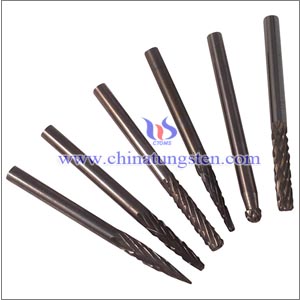Introduction to Tungsten Carbide Tipped Reamers Ⅱ
- Details
- Category: Tungsten Information
- Published on Thursday, 17 September 2015 17:33
(This article is divided into two parts and this is Part Ⅱ. For Part Ⅰ please refer to http://news.chinatungsten.com/en/tungsten-information/78698-ti-10017)
Types Of Tungsten Carbide Tipped Reamers
Reamers can be firstly classified by the number of flutes. Tungsten carbide-tipped roughing reamers may have either an even or an odd number of flutes, depending upon the reamer size and the application. Standard and finishing types usually have an even number of flutes. The spacing of the flutes around the reamer body is sometimes uneven to minimize the possibility of chatter.
Tungsten carbide tipped reamers may be made for either right- or left-hand flutes, or with straight flutes, and may incorporate one, two, or more sections of different diameters for cutting two or more diameters in one operation. Carbide tipped reamers in straight flute design, with strips of tungsten carbide the full length of the flutes, are ideal for precision reaming to close tolerances. The wear on the diameter from bushings is eliminated and back taper can be reduced to a minimum, as danger of pickup on the diameter is reduced.
Solid carbide reamers are more practical in small sizes because of their rigidity, heat resistance, and strength. Tipped reamers in small sizes below ¼ inch are very fragile because of the removal of steel necessary to install the tip. Also, the rapid absorption of heat causes brazing failures in dry operation.
Maintenance
For best efficiency, carbide-tipped reamers house be used only on machines that are in good condition. Loose or misaligned spindles can cause serious damage to a reamer, and the resulting cut will not conform to the desired size or finish.The magnitude of lead and rake angles, width of land, amount of clearance, and whether straight or spiral flutes should be employed are all related to the kind and characteristics of the material in the work piece.
Carbide tipped reamers are generally covered with a plastic coating over the tips for the protection of the cutting edges. This coating may be removed in such a matter that it can be replaced when the tool is not in use. The coolant or lubricant, when used, should be in abundant supply and should wash over the tool at all times to avoid cracking of the carbide from overheating and quenching.
Grinding Suggestions
Reamers should be sharpened as soon as they become dull enough to prevent proper cutting. It usually is necessary to sharpen only the cutting edge or the chamfer, but if it is necessary to regrind the diameter, the correct circular-land width must be maintained, as well as the back taper.Carbide tipped reamers may be reground on a standard cutter grinder with a 220-grit resinoid-bonded diamond cup wheel. The grinding wheel should be rotated in a direction to cut from the face of the tip toward its back (Fig 3-57). The use of a lubricant during grinding lengthens grinding wheel life and lessens the danger of a surface cracking or “crazing” of the carbide from overheating. Do not quench carbide tools in water.

------END-------
Tungsten Carbide Manufacturer & Supplier: Chinatungsten Online - http://www.tungsten-carbide.com.cn
Tel.: 86 592 5129696; Fax: 86 592 5129797
Email:sales@chinatungsten.com
Tungsten & Molybdenum Information Bank: http://i.chinatungsten.com
Tungsten News & Tungsten Prices, 3G Version: http://3g.chinatungsten.com
Molybdenum News & Molybdenum Price: http://news.molybdenum.com.cn



 sales@chinatungsten.com
sales@chinatungsten.com